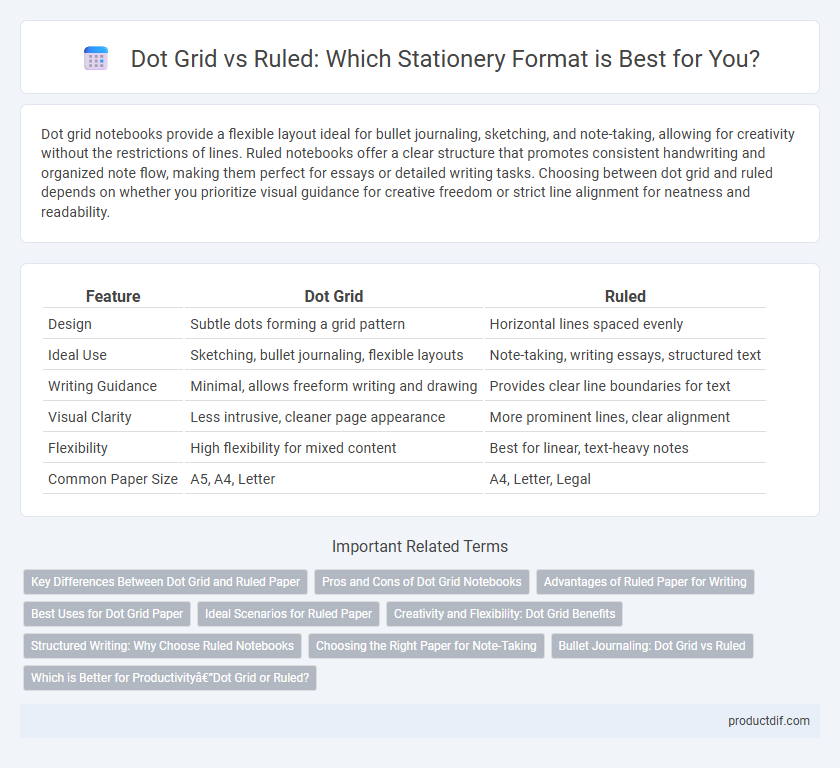Dot grid notebooks provide a flexible layout ideal for bullet journaling, sketching, and note-taking, allowing for creativity without the restrictions of lines. Ruled notebooks offer a clear structure that promotes consistent handwriting and organized note flow, making them perfect for essays or detailed writing tasks. Choosing between dot grid and ruled depends on whether you prioritize visual guidance for creative freedom or strict line alignment for neatness and readability.
Table of Comparison
| Feature | Dot Grid | Ruled |
|---|---|---|
| Design | Subtle dots forming a grid pattern | Horizontal lines spaced evenly |
| Ideal Use | Sketching, bullet journaling, flexible layouts | Note-taking, writing essays, structured text |
| Writing Guidance | Minimal, allows freeform writing and drawing | Provides clear line boundaries for text |
| Visual Clarity | Less intrusive, cleaner page appearance | More prominent lines, clear alignment |
| Flexibility | High flexibility for mixed content | Best for linear, text-heavy notes |
| Common Paper Size | A5, A4, Letter | A4, Letter, Legal |
Key Differences Between Dot Grid and Ruled Paper
Dot grid paper features a pattern of evenly spaced dots that provides a flexible guide for drawing, sketching, and writing, allowing for greater creativity and customization. Ruled paper consists of horizontal lines that maintain consistent text alignment, making it ideal for structured note-taking and handwriting practice. The main difference lies in the visual structure: dot grid offers subtle guidance without intrusive lines, while ruled paper delivers clear, defined writing spaces.
Pros and Cons of Dot Grid Notebooks
Dot grid notebooks provide a versatile writing surface with subtle guidance, ideal for bullet journaling, sketching, and design work due to their unobtrusive dot patterns. They offer more creative freedom compared to ruled notebooks, which can feel restrictive for diagrams or freeform notes, but the lack of strong lines might challenge users who prefer clearer writing boundaries. Dot grids enhance alignment and structure without overwhelming visuals, benefiting users seeking balance between organization and flexibility in note-taking.
Advantages of Ruled Paper for Writing
Ruled paper offers consistent horizontal lines that guide handwriting, enhancing legibility and organization in note-taking or journaling. Its structured format helps maintain uniform letter size and spacing, reducing strain during extended writing sessions. Many writers prefer ruled paper for tasks requiring clear, linear text such as essays, letters, or academic notes.
Best Uses for Dot Grid Paper
Dot grid paper offers optimal flexibility for bullet journaling, sketching, and creative note-taking by providing subtle guides without the constraints of lines. Its evenly spaced dots support precise alignment and freeform layouts, making it ideal for designers, architects, and planners. Compared to ruled paper, dot grid enhances spatial organization while maintaining an open and customizable workspace.
Ideal Scenarios for Ruled Paper
Ruled paper is ideal for note-taking, journaling, and formal writing where structured alignment and consistent line spacing enhance readability and organization. It supports tasks requiring precise handwriting or detailed lists, making it popular among students and professionals. The evenly spaced horizontal lines guide uniform writing, improving clarity in academic and business settings.
Creativity and Flexibility: Dot Grid Benefits
Dot grid notebooks offer unparalleled creativity and flexibility by providing subtle guides without imposing structured lines, allowing freeform sketches, diagrams, and handwritten notes to flow naturally. The evenly spaced dots enhance spatial organization while remaining unobtrusive, making dot grids ideal for bullet journaling, design work, and brainstorming. Compared to ruled paper, dot grids encourage more adaptive layouts and personalized creativity, supporting both artistic expression and precise writing.
Structured Writing: Why Choose Ruled Notebooks
Ruled notebooks provide clear, consistent lines that enhance legibility and organization, making them ideal for structured writing tasks such as note-taking, journaling, and academic work. The evenly spaced lines guide handwriting, reduce distractions, and promote a neat, orderly presentation of thoughts. Compared to dot grid notebooks, ruled paper supports precise alignment and uniformity, which benefits those prioritizing clarity in their written content.
Choosing the Right Paper for Note-Taking
Dot grid paper offers flexible structure with subtle guides, ideal for bullet journaling, diagrams, and creative layouts, enhancing note organization without overpowering the content. Ruled paper provides consistent, straight lines perfect for linear note-taking, ensuring clear, legible handwriting for academic or professional use. Prioritize dot grid for visual freedom and ruled for traditional, structured notes to match your personal or situational note-taking style.
Bullet Journaling: Dot Grid vs Ruled
Dot grid notebooks provide flexible structure with evenly spaced dots, ideal for bullet journaling as they facilitate custom layouts, habit trackers, and creative designs. Ruled notebooks offer consistent, straight lines that support linear note-taking and list-making but limit visual customization. For bullet journaling, dot grid enhances creativity and organization, whereas ruled notebooks emphasize traditional, structured entries.
Which is Better for Productivity—Dot Grid or Ruled?
Dot grid notebooks enhance productivity by offering a flexible structure for sketches, charts, and notes, catering to creative and technical tasks alike. Ruled notebooks provide clear lines that improve handwriting neatness and organization, ideal for extensive writing and note-taking. Choosing between dot grid and ruled depends on whether your productivity benefits more from freeform layout versatility or structured, linear guidance.
Dot Grid vs Ruled Infographic

 productdif.com
productdif.com